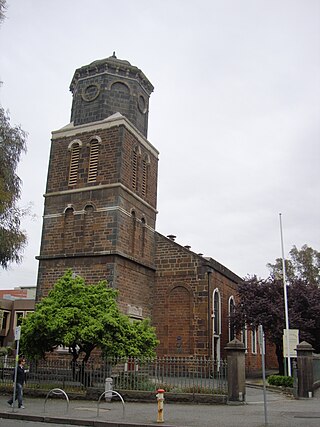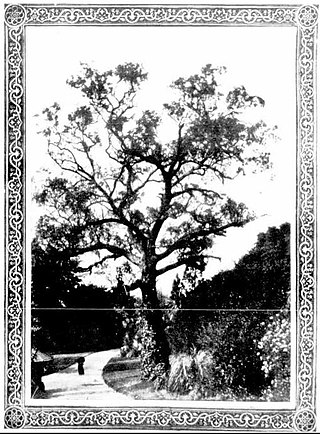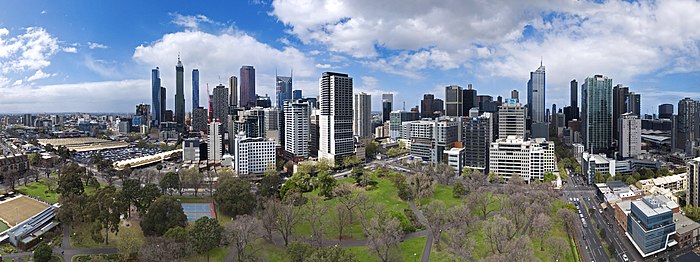
Georg Balthazar von Neumayer, was a German polar explorer and scientist who was a proponent of the idea of international cooperation for meteorology and scientific observation.

Fitzroy is an inner-city suburb in Melbourne, Victoria, Australia, 3 km (1.9 mi) north-east of Melbourne's Central Business District, located within the City of Yarra local government area. Fitzroy recorded a population of 10,431 at the 2021 census.

Fitzroy North is an inner-city suburb in Melbourne, Victoria, Australia, 4 km (2.5 mi) north-east of Melbourne's Central Business District, located within the Cites of Merri-bek and Yarra local government areas. Fitzroy North recorded a population of 12,781 at the 2021 census.

Royal Botanic Gardens Victoria are botanic gardens across two sites–Melbourne and Cranbourne.

East Melbourne is an inner-city suburb in Melbourne, Victoria, Australia, 2 km (1.2 mi) east of Melbourne's Central Business District, located within the City of Melbourne local government area. East Melbourne recorded a population of 4,896 at the 2021 census.

The Carlton Gardens is a World Heritage Site located on the northeastern edge of the Central Business District in the suburb of Carlton, in Melbourne, Australia. A popular picnic and barbecue area, the heritage-listed Carlton Gardens are home to an array of wildlife, including brushtail possums.

The Treasury Gardens consist of 5.8 hectares on the south-eastern side of the Melbourne central business district, East Melbourne, Victoria, Australia. The gardens are bounded by Wellington Parade, Spring Street, Treasury Place, and by the Fitzroy Gardens across Lansdowne street to the west. They form part of a network of city gardens including Fitzroy Gardens, Carlton Gardens, Flagstaff Gardens and Kings Domain. The gardens are listed on the Victorian Heritage Register for their historical, archaeological, social, "aesthetic and scientific (horticultural) importance for its outstanding nineteenth century design, path layout and planting".

La Trobe Street is a major street and thoroughfare in the city centre of Melbourne, Victoria, Australia. It runs roughly east–west and forms the northern boundary of Melbourne's central business district. The street was laid out as an extension of the original Hoddle Grid in 1839 and was named after Charles La Trobe. La Trobe Street extends from Victoria Street in the east to Harbour Esplanade in the west.

The Fitzroy Gardens are 26 hectares located on the southeastern edge of the Melbourne central business district in East Melbourne, Victoria, Australia. The gardens are bounded by Clarendon Street, Albert Street, Lansdowne Street, and Wellington Parade with the Treasury Gardens across Lansdowne street to the west.

Government House is the official residence of the governor of Victoria, currently Linda Dessau. It is located in Kings Domain, Melbourne, next to the Royal Botanic Gardens.

Kings Domain is an area of parklands in Melbourne, Victoria, Australia. It surrounds Government House Reserve, the home of the governors of Victoria, the Sidney Myer Music Bowl, and the Shrine Reserve incorporating the Shrine of Remembrance.

William Robert Guilfoyle was an English landscape gardener and botanist in Victoria, Australia, acknowledged as the architect of the Royal Botanic Gardens, Melbourne and was responsible for the design of many parks and gardens in Melbourne and regional Victoria.

Melbourne is Australia's second largest city and widely considered to be a garden city, with Victoria being nicknamed "the Garden State". Renowned as one of the most livable cities in the world, there is an abundance of parks, gardens and green belts close to the CBD with a variety of common and rare plant species amid landscaped vistas, pedestrian pathways, and tree-lined avenues, all managed by Parks Victoria.

St James Old Cathedral, an Anglican church, is the oldest church in Melbourne, Australia, albeit not on its original site. It is one of the relatively few buildings in the central city which predate the Victorian gold rush of 1851. The building was demolished and relocated in 1914 to a corner site of King Street and Batman Street.

Edinburgh Gardens is a large park located in the inner Melbourne suburb of North Fitzroy. It is bounded by Brunswick Street and St Georges Road to the west, the curve of Alfred Crescent to the north and east, and Freeman Street to the south. It was created from a grant of land in March 1862 by Queen Victoria and laid out by Clement Hodgkinson, who designed many of Melbourne's parks and gardens. At approximately 24 hectares in size, the park is large by inner urban standards.

William Street is a major street in the central business district of Melbourne, Victoria, Australia. It runs roughly north–south from Flinders Street to Victoria Street, and was laid out in 1837 as part of the original Hoddle Grid. The street is located in-between King Street and Queen Street.

The City of Fitzroy was a local government area about 2 kilometres (1 mi) northeast of Melbourne, the state capital of Victoria, Australia. The city covered an area of 3.73 square kilometres (1.44 sq mi), making it the smallest municipality by land area in Victoria, and existed from 1858, until 1994.
The Melbourne City campus of the Royal Melbourne Institute of Technology is located in the city centre of Melbourne in Victoria, Australia. It is sometimes referred to as "RMIT City" and the "RMIT Quarter" of the city in the media.

The Separation tree was a heritage listed Eucalyptus camaldulensis tree, commonly known as a red river gum, located in the Royal Botanic Gardens Victoria in Melbourne in Victoria.
The Fitzroy Gasworks was a coal gasification plant in Fitzroy, Victoria. It is notable as the site for the first arc-welded gasholder in the world.


















